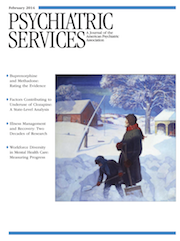Progress in Improving Mental Health Services for Racial-Ethnic Minority Groups: A Ten-Year Perspective
Abstract
Objective
This study examined progress in making the mental health workforce more diverse and in better representing racial-ethnic minority groups in randomized intervention trials of common mental disorders since the publication of the U.S. Surgeon General’s 2001 report Mental Health: Culture, Race, and Ethnicity.
Methods
Data on the mental health workforce were drawn from a work group comprising research staff from the American Psychiatric Association, American Psychological Association, and the National Association of Social Workers; representatives of professional psychiatric nursing; and staff from the National Institute of Mental Health. Additional data were pooled from clinical trials published between 2001 and 2010, which were examined for inclusion of racial-ethnic minority populations. Proquest, PubMed, and Google Scholar were searched for the terms “clinical trials” and “randomized trials.” The search was constrained to trials of adults with bipolar disorder, schizophrenia, and major depression, along with trials of children and adults with attention-deficit hyperactivity disorder.
Results
Between 1999 and 2006, professionals from racial-ethnic minority groups increased from 17.6% to 21.4% in psychiatry, from 8.2% to 12.9% in social work, and from 6.6% to 7.8% in psychology. Reporting race-ethnicity in clinical trials has improved from 54% in 2001 to 89% in 75 studies of similar disorders published by 2010, although few ethnic-specific analyses are being conducted.
Conclusions
Little progress has been made in developing a more diverse workforce; racial-ethnic minority groups remain highly underrepresented. There is more representation of racial-ethnic minority populations in randomized intervention trials, but their numbers often remain too small to analyze. Recommendations for improving both areas are considered.



